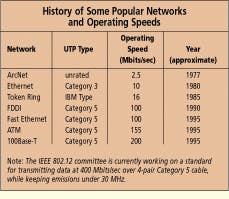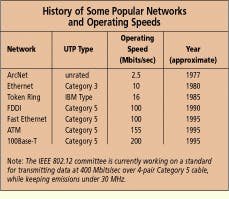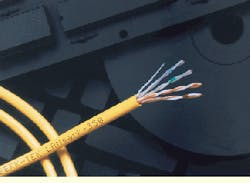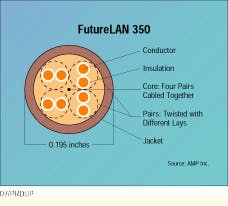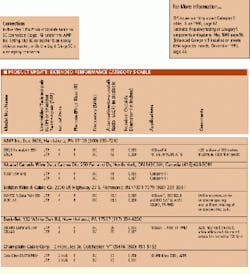Barbara E. Thompson
In the last 15 years, operating speeds for telecommunications applications have increased from 2.5 (ArcNet) to 155 megabits per second (Asynchronous Transfer Mode) and higher. These increased speeds need higher-bandwidth cables, and manufacturers continue to develop cabling solutions for future higher-speed applications--commonly known as headroom or future-proofing. Extended-performance (or extended-frequency) Category 5 cable is now offered as a product tested by manufacturers to frequencies higher than the TIA/EIA-568A standard of 100 megahertz for Category 5 (see product tables, page 22).
No recognized industry standard exists, however, for 100-ohm unshielded twisted-pair (UTP) cable at frequencies beyond 100 MHz. And, with the speed at which telecommunications technology continues to develop, it is difficult to predict how much faster applications will run in the future. Is extended-performance Category 5 UTP cable the answer for future telecommunications applications, or is it just a solution until the next standard issues?
"The real challenge for a cable manufacturer," says Brian Griggs, engineering manager at Hitachi Cable Manchester, "is to take the existing standard and improve it in the frequency range that`s going to best fit customers` needs. Instead of testing to 350 MHz, we should improve crosstalk and reduce structural return loss and attenuation at or below the current standard of 100 MHz."
As network bit-streams increase, cables need to have better electrical performance. Extended-performance Category 5 cable does offer improved signal transmission. "This product displays enhanced characteristics for all of the electrical parameters required by the TIA/EIA-568A standard and the Underwriters Laboratories verification program," says Griggs. "This is important because 100-plus Mbit/sec topologies will become commonplace due to bit-density enhancements, not frequency growth."
"Basically, attenuation and near-end crosstalk properties are the two areas we`re concerned with," says Mark Mahoney, senior project manager at Semans Communications (San Carlos, CA). "With the extended Category 5 cable, the bandwidth window has proven to be a little higher--more headroom for extended distances."
According to John Troy, president of Connectivity (Nashua, NH), "We used extended-performance Category 5 in an installation because the manufacturer specified it and the customer felt it would provide more headroom. It was a fairly unique application, however, with somewhat longer lengths of runs. The customer wanted one central closet, not multiple wiring closets, so the runs were longer."
Buying insurance
Network designers are looking for cable that can provide for future applications, and replacing cabling can be difficult and expensive. "You`re buying insurance," says Brian Induni, marketing communications manager at Champlain Cable Corp. "Today, you`re running 10Base-T, tomorrow 20 Mbits/sec, and down the road you may be running 100 Mbits/sec. But you will still have that much more bandwidth to ensure that your data is going to get to the other end essentially error-free."
Connectivity`s Troy expresses a different opinion, though. "My perspective is that extended-performance Category 5 cable is a niche product. Users are beginning to believe that this cable is some sort of panacea for longer runs and more headroom, but I think the jury is still out. There hasn`t been a verdict yet whether these extended-distance cables are going to withstand long-term, high-speed demand."
Because the standard for Category 5 is clearly specified for runs of 100 meters, certification can be an issue. "We have explained to our customers that we can test it and give them the test results, but it clearly does not meet Category 5 certification [when links are more than 100 meters]," Troy says. "It is not our policy to recommend extended-distance cable to our end-users. Of course, we will discuss with them the relative benefits of that cable. However, if end-users are that concerned about bandwidth in the near term, then perhaps they really need to be thinking about fiber-optic cable."
Changing standards
Indeed, the standards for Category 5 cable continue to change. The Telecommunications Industry Association (Arlington, VA) has issued a warning about copper-cable properties in a press release, which states, "Some high-speed local area network specifications require cabling with requirements not now specified in TIA/EIA-568A. These requirements are propagation delay and delay skew."
At this time, however, the TIA/EIA-568A standard recommends that Category 5 cabling support 100-MHz electrical signals, and it also defines the electrical parameters required. For example, it states that the difference between attenuation and near-end crosstalk at 100 MHz should be at least 10 decibels for standard test lengths of 100 meters.
Attenuation-to-crosstalk ratio (ACR) is defined as the difference between attenuation and crosstalk measured in dB at a given frequency. This difference is critical to ensure that the signal sent down the twisted-pair cable is stronger at the receiving end of the cable than any interference signals (crosstalk) from other cable pairs.
"Where you can affect the performance of the cable most--what`s going to transmit the signal from point A to point B without bit errors or interruptions--are attenuation and crosstalk," says Kevin Whitaker, marketing director at Commscope Inc. "Those are the two key parameters. Structural return loss and impedance are also important requirements."
If the ACR goes down to zero or less, interference signals will overpower the signal sent down the pair. For installed cabling systems, an ACR of at least 12 dB is considered acceptable for most applications. Any additional margin above the specification is known as headroom. "Ten decibels is the cutoff value," says Induni. "So the higher the value, the better. With anything below that ACR-- 9 dB, for example--there will be no differentiation between signal and noise."
FCC emission standards
Another requirement--Federal Communications Commission (FCC) emission standards--also has to be considered for future applications. Griggs explains: "I believe that somewhere beyond 30 MHz, certain emission issues outlined in Part 15, subsection B of CFR 47, may come into play. Depending on the encoding scheme and signal strength of the topology used, these regulations may prohibit transmission characteristics over 100 MHz on UTP--maybe even up to 100 MHz. At least one company is successfully running 9- and 11-bit cycles right now. If you had 9 bits at 30 MHz, you`re at 270 Mbits/sec; or at 11-bit cycles, you`re at about 330 Mbits/sec," he explains.
"You can get 155 Mbits/sec out of 31 MHz and stay compliant with the FCC regulations right now; people are doing it," says Griggs. "And although we test our cable through 350 MHz, the real benefit is that crosstalk, attenuation and structural return loss are better than standard Category 5 cable, and impedance is plus or minus7 ohms, compared to plus or minus15 ohms through 100 MHz."
Cable design and installation
Most of the cable manufacturers claim that their extended-performance Category 5 cable has better ACR than standard Category 5 cable, which can also improve impedance and structural return losses over current standards.
To reach these improved electrical parameters, manufacturers have come up with different cable designs. For example, in one case, the manufacturer has bonded the individual insulated conductors together to provide uniform conductor-to-conductor spacing and uniform twisting of insulated conductors into pairs. Another cable design features a flattened configuration, which also controls pair-to-pair spacing. In addition, one U.S. manufacturer provides enhanced Category 5 cable that is individually foil-shielded or foil-and-shield shielded twisted-pair (STP) cable.
Although these cable designs improve the electrical parameters, they may take more time to install. "In the case of fused pairs, stripping is a little more difficult, adding a fraction more time to install," says Mahoney. "There is a learning curve but our installers have figured out ways to do it. However, we feel that no matter what you hook up to this cable, provided you have the network equipment, it will run at whatever speed and megahertz rating you require."
For extended-frequency applications, however, the European Community may have the right solution by using STP cable. "When all the dust clears, 350-MHz networks are only going to be satisfied with a screened, or shielded and screened, twisted-pair cable," says Griggs.
LANmark 350 from Berk-Tek and FutureLAN 350 from AMP are examples of enhanced-performance Category 5 cables tested by the respective manufacturers to 350 megahertz.
Megahertz, Megabits and Bandwidth
With all this discussion about megahertz (MHz) and megabits (Mbits), it may help to explain that cables are characterized to electrical signals (in megahertz), not bit-streams. Applications, however, are specified in megabits-per-second and, once installed in the network, the bit-speed has to fit into a specified bandwidth.
Bandwidth is a range of frequencies--the width of the channel. It is often used to denote the total capacity of the network, including the frequency range and the sustainable transmission speed.
